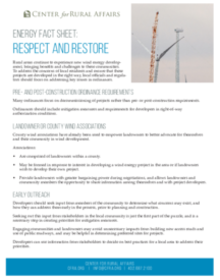Rural areas continue to experience new wind energy development, bringing benefits and challenges to these communities. To address the concerns of local residents and ensure that these projects are developed in the right way, local officials and regulators should focus on addressing key issues in ordinances.
Pre- and Post-Construction Ordinance Requirements
Many ordinances focus on decommissioning of projects rather than pre- or post-construction requirements.
Ordinances should include mitigation measures and requirements for developers in right-of-way authorization conditions.
Landowner or County Wind Associations
County wind associations have already been used to empower landowners to better advocate for themselves and their community in wind development.
Associations:
- Are comprised of landowners within a county.
- May be formed in response to interest in developing a wind energy project in the area or if landowners wish to develop their own project.
- Provide landowners with greater bargaining power during negotiations, and allows landowners and community members the opportunity to share information among themselves and with project developers.
Early Outreach
Developers should seek input from members of the community to determine what concerns may exist, and how they can address them early in the process, prior to planning and construction.
Seeking out this input from stakeholders in the local community is just the first part of the puzzle, and is a necessary step in creating priorities for mitigation measures.
Engaging communities and landowners may avoid unnecessary impacts from building new access roads and use of public roadways, and may be helpful in determining preferred sites for projects.
Developers can use information from stakeholders to decide on best practices for a local area to address their priorities.


